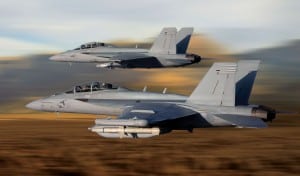The Navy said on Tuesday that the operational F/A-18E/F Super Hornet and EA-18G Growler fleets achieved the 80 percent mission-capable (MC) readiness rate mandated by the Secretary of Defense.
Both aircraft types stand above 80 percent of primary Mission Aircraft Inventory (PMAI) at 343 and 95 aircraft, respectively, the Navy said. The Navy has a total of over 500 Super Hornets, with these MC goals applying to the operational aircraft.

In fall 2018 then-Secretary of Defense James Mattis directed the services to reach an 80 percent MC rate across fighter and strike fighter aircraft squadrons by the end of FY ’19. The push came amid MC rates at the time standing around a mere 50 percent.
After a decade of maintaining 250-260 MC F/A-18s, the Navy is now sustaining more than 320 Super Hornets and surged to reach service goals of 341 MC Super Hornets and 93 Growlers in September, Vice Adm. DeWolfe H. Miller III, commander of Naval Air Forces and Naval Air Force Pacific Fleet said.
“This has been a year of results for Naval Aviation. I am incredibly proud of our Sailors, civilian teammates and industry partners. They developed and implemented the NSS (Naval Sustainment System) and then drove readiness numbers that haven’t been seen in over a decade” Miller said in a statement.
A Navy spokesperson told Defense Daily the operational Super Hornets under this count are those in the Primary Mission Aircraft Inventory, meaning those that make up the nine carrier air wings that deploy.
Cmdr. Ron Flanders, spokesperson for Commander of Naval Air Forces, said other aircraft that do not count in the operational classification are training squadrons, test aircraft, and the aircraft in the Navy Strike Fighter Tactics Instructor program (TOPGUN).
In May, then-Acting Defense Secretary Patrick Shanahan told lawmakers the Navy had made “significant progress” and was on track to reach the 80 percent goal by the end of FY ’19 (Defense Daily, May 1).
The Navy underscored the Naval Aviation Enterprise implemented the Naval Sustainment System-Aviation (NSS-A) to achieve this. NNS-A leverages best practices from commercial industry to update and improve aspects of Naval Aviation’s maintenance practices in squadrons and intermediate and depot Fleet Readiness Centers. The service also reformed supply chain management, engineering practices, governance activities and safety.
“Initially, NSS-A focused on getting the Navy F/A-18 Super Hornet fleet healthy, but quickly grew to include the Navy’s EA-18G Growler fleet due to the similarities in the two platforms. Ultimately, the Navy and Marine Corps will apply NSS-A reforms to recover and sustain readiness and improve safety for each type, model and series of aircraft,” the Navy said in a statement.
Rear Adm. Roy Kelley, Commander, Naval Air Forces, Atlantic (CNAL), noted the leading indicator of aviation readiness has moved in the right direction, aviator flight hours.
“This is the first year in some time that we have executed our allocation of flight hours completely. That stands as a sign of health that we have a lot of ‘up’ aircraft, and that the parts are moving. We’re getting healthy and we’re on the right track,” Kelley said.
Miller agreed this is an important milestone, but the service is not done yet.
“To be clear, there is no finish line to the NSS effort. We don’t get to choose when we are called to fight. Sustainment is the key. Continuously improving the reforms implemented by our military, civilian and industry teams will be critical in maintaining our advantage in this age of great power competition,” Miller added.